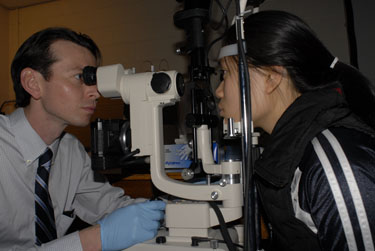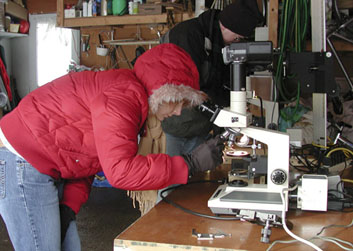 |
 |
 |
The Biomedical Photographic Communications (BPC) program
at the Rochester Institute of Technology
by Professor Michael Peres, chair
Biomedical Photographic Communications
 |
 |
 |
Some equipment and facilities of the RIT Biomedical high magnification laboratories including the "snow flake shack"
The Biomedical Photographic Communications (BPC) program at the Rochester Institute of Technology is the only program in the US that still grants a Bachelor of Science degree in this unique area of visual communications. The Biomed curriculum prepares students for photographic and imaging careers found in various science related institutions including: forensic labs, pharmaceutical companies, health care and medical research centers, ophthalmic practices, law enforcement and military organizations. Additionally, because of curriculum's flexibility, recent graduates have been successful finding positions in the electronic imaging field as technical service representatives or producers of multimedia or web publishing.
During the first two years of the program, students receive a solid foundation in applied digital photography in science. Course work includes topics such as close-up and high magnification photography, studio lighting, ethics, forensic photography, invisible spectrum work and ophthalmic diagnostic imaging. Introductions to desktop and web publishing, poster design, biology, and liberal arts courses round out the freshman and sophomore experience. By the end of their second year, students will have been introduced to a wide variety of career options through the program's interactive lecture series with professional biomedical and new media experts, which assists them in identifying and securing a work study position for the summer. The BPC program requires all students to have completed at least one co-op/internship prior to graduation. Co-ops are an opportunity for students to gain experience in their chosen field and are generally undertaken between their second and third academic year. Most co-ops are paid positions, and typically are eight to ten weeks long at 20-40 hours/week.Many students coop in biology research facilities such as the Smithsonian, Woods Hole Marine Biology Laboratory or in ophthalmic photographic positions. In the junior and senior years, the curriculum shifts to a flexible path allowing students to customize their own photographic concentration. Electives taken from a wide variety of courses taught in the College of Imaging Arts and Sciences, the College of Science, or the College of Applied Science’s Information Technology program and can be used complete degree credit requirements. Working closely with academic adviser, students typically focus this period towards personal career or educational goals. It is not uncommon to have students go on to graduate studies in imaging, medicine or information technology. |
For more information visit the main Biomedical Photography Web Site at biomed.rit.edu
below to view previously printed RIT student articles
Article hosted on Micscape Magazine (Microscopy-UK).